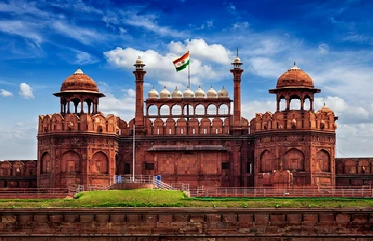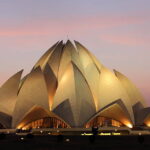The Red Fort, or Lal Qila, is an iconic monument located in the heart of Old Delhi, India. Built during the 17th century, it stands as a magnificent symbol of Mughal architecture and power. The fort’s construction was initiated by the Mughal Emperor Shah Jahan in 1638 and was completed in 1648, serving as the main residence of the Mughal emperors for nearly 200 years.
The name “Red Fort” derives from the massive red sandstone walls that enclose its vast compound, stretching over 2 kilometers in perimeter. These walls rise up to 33 meters in height, punctuated by imposing bastions and intricate carvings, showcasing the architectural grandeur of the Mughal era. The fort is a fusion of Persian, Timurid, and Indian architectural styles, reflecting the cultural diversity and artistic sophistication of the period. Entering through the Lahore Gate, visitors are greeted by the Chatta Chowk, a bustling market street that once housed the royal bazaar. Beyond lies the Naubat Khana, or Drum House, where musicians would announce the emperor’s arrival with melodious tunes. The grandeur of the Diwan-i-Aam, or Hall of Public Audience, and the Diwan-i-Khas, or Hall of Private Audience, leaves visitors in awe with their intricate marble inlays, ornate arches, and exquisite lattice work. One of the most iconic features of the Red Fort is the stunning Moti Masjid, or Pearl Mosque, an architectural marvel crafted from white marble. Its serene beauty stands in contrast to the vibrant red hue of the fort’s walls, creating a captivating visual spectacle.
The fort’s sprawling gardens, known as the Hayat Bakhsh Bagh or “Life-Bestowing Gardens,” provide a tranquil retreat from the hustle and bustle of the city. Lush greenery, cascading fountains, and elegant pavilions transport visitors to a bygone era of opulence and refinement.Throughout its history, the Red Fort has witnessed significant events, from grand imperial ceremonies to pivotal moments in India’s struggle for independence. It was here that the Indian National Flag was hoisted for the first time on August 15, 1947, marking the end of British colonial rule and the dawn of a new era for the nation. Today, the Red Fort stands as a UNESCO World Heritage Site and serves as a symbol of India’s rich cultural heritage. It attracts millions of visitors annually, who come to marvel at its architectural splendor, explore its storied past, and immerse themselves in the legacy of the Mughal Empire. As a testament to the enduring legacy of India’s glorious past, the Red Fort continues to inspire awe and admiration in all who visit it.
The Red Fort’s historical significance, architectural beauty, cultural heritage, national importance, tourist amenities, and strategic location make it a top tourist attraction in India, drawing millions of visitors each year to marvel at its splendor and immerse themselves in its rich tapestry of history and culture.


